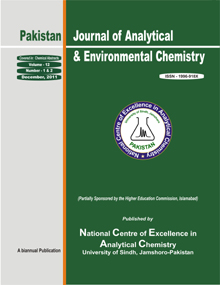A Cyclic Voltammetric Studies of Complexation of Copper (II) with Thymine Using Glassy Carbon Electrode in Aqueous Medium
DOI:
https://doi.org/10.21743/Keywords:
Complexation; Nucleobase; Voltammetry; Electrolyte; LigandAbstract
Voltammetric behaviors of copper (II) complex with nitrogen bearing nucleobase, thymine (C5H6N2O2), was studied using cyclic voltammetry (CV) on a glassy carbon electrode. Assessment of the chemical and physical conditions that may favor optimum current enhancement was done by studying the effect of variation of concentration of metal and ligand ions, scan rate, step height, pH values and supporting electrolyte as (NH4)2SO4, KCl and NaCl. It was observed that copper and thymine forms a 1:1 ratio complex and increasing the concentration of either metal ion or ligand ion increases the corresponding current. Increasing the scan rate increases the corresponding current linearly with the square root of the scan rate. As the step height decreases the peaks become sharper. Anodic and cathodic current increases linearly with decreasing step height. The highest degree of complexation was observed at pH ranging from 2.3 to 7.0. However, poor complexation was observed in slightly alkaline medium. The complexing order trend of supporting electrolytes was observed as (NH4)2SO4>NaCl>KCl.
Downloads
Downloads
Published
Issue
Section
License
Copyright (c) 2025 Pakistan Journal of Analytical & Environmental Chemistry

This work is licensed under a Creative Commons Attribution-NonCommercial-ShareAlike 4.0 International License.











